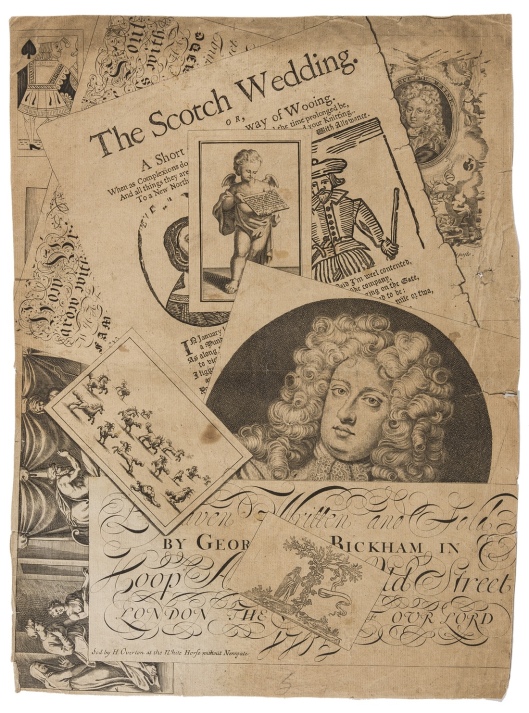A short post to share an image of an interesting auction find – A trompe-l’œil medley print advertising the skills of the engraver George Bickham the Elder (1683/84-1758). Although chiefly remembered as an engraver of ‘serious’ subjects such as portraiture and calligraphy, Bickham also turned his hand to political and social satire during the early years of the eighteenth-century and appears to have exhibited a particular fondness for medley prints. Medleys were engravings designed to look as though a series of separate prints had been casually arranged on a table or other flat surface. They worked on a number of levels; as crude optical illusion, as an advertisement for the multifaceted skills of the engraver and as satire. Bickham’s The Whig’s Medley (1711) for example, attacks the writer Daniel Defoe by arranging a mock frontispiece to one of his works alongside images of the regicide Oliver Cromwell, a “deformed head in the pillory” and the knaves from a deck of playing cards. This image may also have a satirical subtext but if that is the case then I must admit that it’s largely lost on me – although the representation of a woodcut illustrated squib entitled The Scotch Wedding is presumably a reference to the Act of Union between England and Scotland which was under negotiation at the time this print is likely to have been published?
The date of publication can be estimated from the address which appears on the mock trade card panel at the bottom of the plate, as George Bickham is thought to have lived in Hoop Alley, Old Street, around 1705. The British Museum owns two other versions of the same print. The first is identical to this one but carries the publication line of Cluer Dicey (c.1713-1775) in place of those of Henry Overton’s (1676-1751). The second was published by Overton but has been modified to include an additional playing card in the bottom right hand corner which obscures Bickham’s address (presumably because he no longer lived there). This suggests that either Bickham engraved multiple plates, or that the same plate was passed back and forth between the two publishers over a period of time.


I have noticed that the Grant plate 129 in your excellent book is very closely based on Robert Seymour’s Coloured lithograph depicting a Whig steam carriage ( similar to Walter Hancock’s steam carriage Actually running on the road at that time) in McLean’s Monthly Sheet of Caricatures, July 1833 edition.
I would be happy to send an image if of interest.
Ah very interesting. It’s certainly not surprising, as Grant seems to have ‘borrowed’ several ideas from Seymour, H.B. and other contemporary caricaturists in order to keep pace with demand for new numbers of The Political Drama. I’d love to see an image if you have one and glad you’re enjoying the book. Thanks.